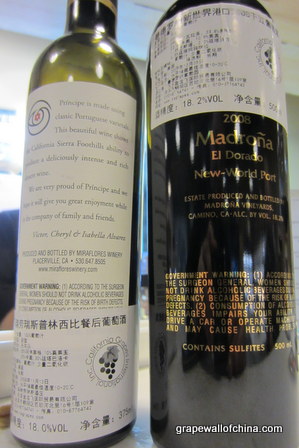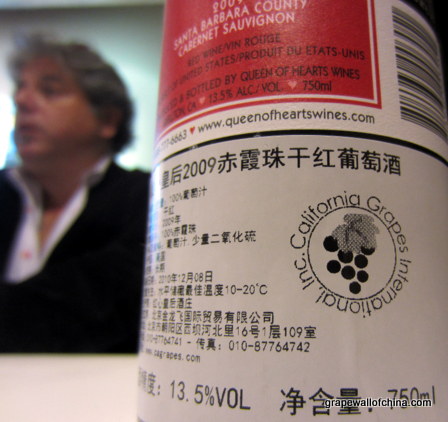By Jim Boyce
Why does the import sticker always cover the back label?
This is a common pet peeve of imported wine buyers in China. They pick up a bottle, check the back and see an import sticker that covers the label and makes it impossible to read more about the wine. Countless times I have seen someone squinting in an attempt to decipher the faintly visible tasting notes under that sticker or get frustrated while trying to (unsuccessfully) peel it.
And while I’ve heard people say Customs regulations dictate sticker placement, such is not the case, says Frank Yglesias of California Grapes. At his shop, no stickers cover labels.
Yglesias says the regulations dictate font sizes on a sticker but there is leeway for its shape and placement. He chooses to make and stick them so the label can be read and thus give customers more information.
I’ll dig a bit more into this issue and post some examples of sticker covering labels. More soon…
Sign up for the Grape Wall newsletter here. Follow Grape Wall on LinkedIn, Instagram, Facebook and Twitter. And see my sibling sites World Marselan Day, World Baijiu Day and Beijing Boyce. Grape Wall has no advertisers, so if you find the content useful, please help cover the costs via PayPal, WeChat or Alipay. Contact Grape Wall via grapewallofchina (at) gmail.com.



Are Chinese stickers used to hide a missing lot number or other unique ID information on the original label? Manufacturers might want to know if their product is being distributed via non-authorized channels, and can only do so by matching the bottle being sold to the original distributor. At some stores, a sliver of the label is removed for some booze (e.g., Bombay Sapphire). Covering up the scar with a label would make it less obvious. In addition, the Chinese label is usually placed over the contact details of the manufacturer or another distributor, making it just a bit harder for a consumer to find another avenue to acquire the product.
I tend to agree with Dan, it is not compulsory that the label in Chinese hides original’s back-label. However there might be a kind of psychological reason. With so many fakes around, inexperienced Chinese buyers feel more comfortable seeing the Chinese label on top of the original. Similar to stamp a seal on top of a signature. I don’t claim that it is a solid reason but I’ve heard it quite a few times from novice shoppers of wine and some importers.
Best.
Rafa
Shanghai
Thanks Dan,
I’ve been told that different Customs offices in China can have different interpretations of the rules and can ask that the import sticker cover be placed over the back label. Have you run into any such situations?
Cheers, Boyce
Hi Jon,
Frank Yglesias, who set up the wine shop, says the portfolio includes around 300 wines total, from all over the state.
Cheers, Boyce
As the Chinese Government dictates the amount of detail & size of fonts on the importer sticker, whether this covers the back label or not will dpend on the size and dimensions of the back label the wine producer uses.
For example here in Australia we have some clients who export their domestic wines to China and therefore in most cases the importer sticker covers part of the back label, as their standard domestic back label contains a great deal of information about their wine. other clients package specifically for China and thus they have (on our advice) tailored their back label so as to be able to have the importer sticker placed without obscuring the product information on the back label.
Thus the covering of the back label is solely dependent on the original purpose/market the wine was destined for.
Cheers
Dan Traucki – J.P., MWCC
WINE ASSIST Pty Ltd
Wine Industry Consultants
Web site: http://www.wineassist.com.au
E mail: dan@wineassist.com.au
Justice of the Peace in the State of South Australia
Chairman- Exporter’s Association of South Australia
MWCC- Member Wine Century Club.
wow a couple sierra foothills wine bottles from my neck of the woods
The obvious is the translation. Something else we found out was that if this additional sticker is on the bottle, it is a good sign (to the Chinese buyers) that is is indeed an imported wine. Yes these too are also faked and copied. If the producer incorporates the translation onto the label here in the USA, this is not as good as an additional label added in China when the wine arrives, so I am told. Go figure.